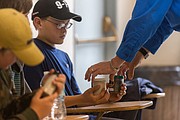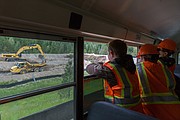Hecla hopes to show students paths to careers at Montanore, Rock Creek mines
Hecla Mining Company hopes someday to be able to show local students a clear path to a career in mining at its proposed Montanore and Rock Creek mines.
“We have a great opportunity to invest in our education programs so that the kids coming out of the Lincoln and Sanders county school systems, even northern Idaho, have the skillsets that could allow them to stay in the area and work,” said Vice President for External Affairs Luke Russell.
There’s much to be worked out yet — both mines remain held up in the permitting processes, for starters — yet Russell said Hecla has already been holding conversations with local educators and has even started giving tours to local middle school students.
Though Russell said nothing is set in stone, Hecla has a map to follow. At its Greens Creek mine in Alaska, the company’s “Pathway to Mining Careers” program has helped it develop careers for local students — and skilled employees for Hecla — since 2011.
In the Greens Creek program, Russell said they started exposing students to the mining career pathway as early as the third grade. In Montana they might wait a few years.
“Middle school kids are just starting to think about ‘What do I want to do?’” Russell said. “(We want) to expose them at that point to a lot of different things that they might be able to do.”
In modern mining, Russell said there are many different stereotype-busting roles to fill. Fewer than half are the “mining guys” that quickly come to mind. The balance, he said, includes engineers, geologists, accountants, environmental health and safety workers and more.
“There’s just this wide spectrum of transferable skills that our industry needs,” Russell said.
In its Greens Creek program, Hecla partners with the University of Alaska Southeast. In Northwest Montana Russell said it could look to partner with a school such as Flathead Valley Community College or North Idaho College to offer education that could range from a certificate to a four-year degree.
Russell said he’s also talked with Craig Barringer, Libby Schools Superintendent, to discuss ways in which Libby schools can help with career training.
Cory Andersen is a teacher at Troy High School who holds a summer science class through GEAR UP, a program sponsored by the Montana University System that readies students for postsecondary education (the acronym stands for “Gaining Early Awareness and Readiness for Undergraduate Programs). Over two days in June, Andersen and about half a dozen seventh and eighth graders toured the Troy Mine, which is under reclamation, and Montanore Mine, which is awaiting permitting.
“(The students) enjoyed it,” Andersen said. “It’s eye opening. (Hecla) took us through the whole process of what they’re going through and what they plan to do in the future.”
The students got to see and hold ore samples and don safety vests and hard hats to see firsthand aspects of mining operations. They also watched presentations on the myriad of mining jobs that Russell said are available in a modern mine.
Not everyone who grows up here wants to stay, Russell acknowledged. “(But) if you have people say this is where I want to be, let’s give them the skillsets and the education so that they could stay home and raise their family and then have jobs for decades if Rock Creek and Montanore can get permitted.”





